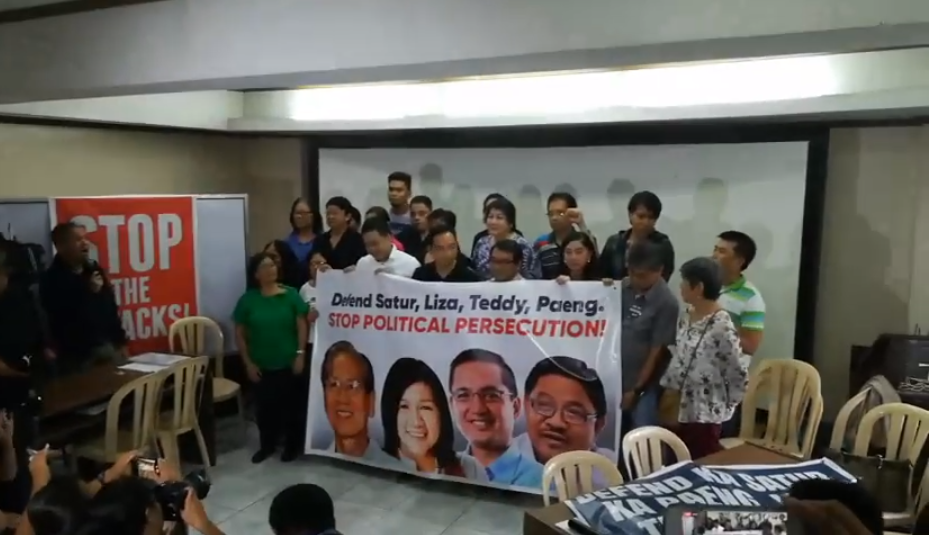Batasan 4: Missing the Real Story

Screengrab from Bagong Alyansang Makabayan press conference Facebook live stream.
REPORTING ON the arrest order for the “Batasan 4,” most media accounts did not seem to find anything strange or surprising about four public figures being hunted down as murderers by the police. These included three former government officials and one incumbent head of a national agency of Cabinet rank.
Reported on July 27, Judge Evelyn Turla of Palayan, Nueva Ecija Regional Trial Court (RTC) Branch 40 issued a warrant of arrest, dated July 11, against former Bayan Muna representatives Satur Ocampo and Teddy Casiño, former Anakpawis representative and ex-agrarian reform secretary Rafael Mariano, and former Gabriela representative and current National Anti-Poverty Commission secretary Liza Maza.
The reports noted that the arrest order arose from an old case which had been set aside due to lapses in the preliminary investigation. None of the reports recalled the context at the time when extrajudicial killings and enforced disappearances became the subject of investigation by the United Nations Special Rapporteur on extrajudicial, summary or arbitrary executions, Philip Alston (See report here). Human Rights Watch (HRW) in 2009 said the number of human rights violations rose in 2006 after then President Gloria Macapagal Arroyo declared an “all-out-war” against the New People’s Army (NPA). Major General Jovito Palparan Jr., who rose to notoriety due to rights abuses, pursued an aggressive anti-communist campaign, targeting political activists, left-leaning groups and suspected communist rebels. Arroyo, during her state of the nation address in 2006, acknowledged Palparan’s efforts. Ordered arrested in 2011, Palparan went into hiding and was captured in 2014. He is currently facing charges.
During a press conference called by Bagong Alyansang Makabayan (BAYAN), a statement of the four accused was read; as militant groups and other concerned parties called the arrest order a form of political harassment, describing the timing as “strange” and a “bad omen,” noting that the revival of the case has coincided with Arroyo’s taking over as Speaker of the House.
Initial reports on the topic in online news websites and evening newscasts on July 27 drew clips from the press conference. Newspapers in their July 28 editions followed suit, with the Inquirer and Star recalling statements from the respondents’ camp in the press briefing, and adding some background information on the case.
The media also cited Presidential Spokesperson Harry Roque calling for the surrender of the four, and denying Malacañang’s involvement in the revival of the case.
The news gave information coming from two opposing sides, thus presenting a reality as viewed partisans. The media failed to get to empirical sources so as to inform the public about circumstances which contextualize the sudden revival of the case. Most of the reports also failed to note the development in the light of the falling out between President Rodrigo Duterte and the Left, as well as Arroyo’s return to power.
CMFR monitored the reports on the subject in the broadsheets Manila Bulletin, the Philippine Daily Inquirer and The Philippine Star; free TV primetime newscasts 24 Oras (GMA-7), Aksyon (TV5), News Night (CNN Philippines) and TV Patrol (ABS-CBN 2); as well as selected news sites from July 27 to August 7, 2018.
Background Details Missing
The coverage by media in general lacked basic information vital to public understanding of what was happening.
Only Rappler and the CNN Philippines news site on July 27 recalled relevant facts of the case: that Bayan Muna had filed and won a civil suit against the complainants in 2007; that the case had been “set aside” by Judge Turla and remanded to the provincial prosecutor in 2008; and that the Supreme Court had ruled in 2017 that remanding the case was “improper” and it was “incumbent” for Judge Turla to determine probable cause, which meant, given the lapses, she should have dismissed it. In addition, CNN Philippines also noted that one other similar murder charge was dismissed in 2008.
While some media reports briefly noted these details, there was little background included in the subsequent accounts, as it tracked developments after July 30, including Batasan 4’s plan to file a motion for reconsideration. After which, it was the side of police and Malacanang: calls for their surrender, and the announcement of reward money by anti-crime group Citizen’s Crime Watch for any information or leads that would lead to the Batasan 4’s arrest.
The Inquirer’s editorial stood out for its detailed review of Judge Turla’s action in 2008 when she found lapses in the prosecutorial process. Media should have followed this point from the very beginning, review the documents of the hearing then to be able to answer the questions: Why did Judge Turla, who reportedly inhibited herself on August 3, revive the case? Had new evidence been found? Why didn’t she dismiss the case then? Why did it take her ten years to find probable cause? These questions should have been asked by the press the moment the arrest warrant was announced.
That reference should have been retained in media accounts of government actions which followed the case to remind the public that this is a decade old case that had already been dismissed by judiciary.
Missing out on the long and broad context of the first case, the media has allowed the impression to be fixed in the news: that the Batasan 4 are now in hiding as fugitives, such action a reflection of their guilt. Worse, the media’s failure to bring the judicial facts at the heart of its reporting allows the public to accept as a norm the intrusion and interference of executive and legislative branches in the judicial process.
It goes without saying that if the judiciary has been captured by the executive that becomes the main story for the media. Nothing much else matters as much as the public realizing and appreciating the real damage to our democratic system.
Leave a Reply